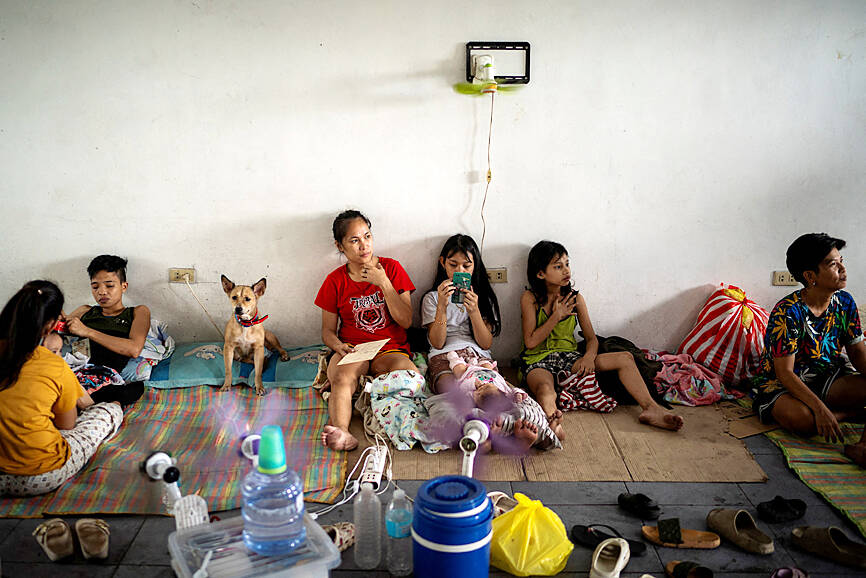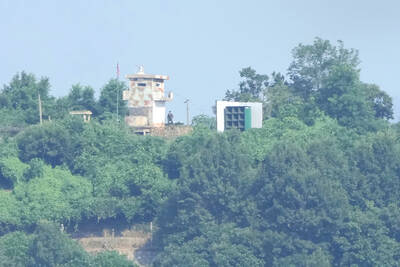Typhoon Man-yi yesterday slammed into the Philippines’ most populous island, with the national weather service warning of flooding, landslides and huge waves as the storm sweeps across the archipelago nation.
Man-yi was still packing maximum sustained winds of 185kph after making its first landfall late on Saturday on lightly populated Catanduanes island.
More than 1.2 million people fled their homes ahead of Man-yi as the weather forecaster warned of a “life-threatening” effect from the powerful storm, which follows an unusual streak of violent weather.

Photo: Reuters
Man-yi uprooted trees, brought down power lines and smashed flimsy houses to pieces after hitting Catanduanes in the typhoon-prone Bicol region.
No deaths have been reported, but there was “extensive” damage to structures on Catanduanes, Office of Civil Defense Administrator Undersecretary Ariel Nepomuceno said.
Man-yi remained a typhoon as it hit heavily populated Luzon — the country’s economic engine — forecasters said, warning of a “potentially dangerous” situation in Aurora province.
“Significant weakening” was expected as it traversed the mountainous island, but severe flooding and landslides were expected as Man-yi dumped “intense to torrential” rain over provinces in its path, the Philippine Atmospheric, Geophysical and Astronomical Services Administration said.
Forecasters also said storm surges of up to more than 3m could swamp vulnerable coastal communities, including in Manila.
Panganiban municipality in the northeast of Catanduanes took a direct hit from Man-yi.
Photographs and a drone video posted on Facebook by Catanduanes Mayor Cesar Robles showed fallen power lines, damaged and destroyed buildings, and trees and corrugated iron sheets strewn on the roads.
“Pepito was so strong, I have never experienced a typhoon this strong,” Robles wrote, using the local name for Man-yi, as clean-up efforts got under way and people returned home. “It is still a bit unsafe, there are still bursts of wind and there are many debris.”
Mother-of-three Marissa Cueva Alejandro, 36, who grew up in Catanduanes and sheltered with a relative during Man-yi, said typhoons were getting stronger.
“Before, we would only experience [typhoon] signal No. 3 to 4, but now typhoons are getting as strong as signal No. 5,” she said, referring to the weather service’s five-tiered wind warning system.
Man-yi is the sixth storm in the past month to batter the nation. At least 163 people died in the previous storms, that also left thousands homeless and wiped out crops and livestock.
About 20 big storms and typhoons hit the Southeast Asian nation or its surrounding waters each year, killing scores of people, but it is rare for multiple such weather events to take place in a small window.
The weather forecaster has hoisted its highest and second-highest typhoon signals over a wide band of provinces stretching from Luzon’s east coast, where Man-yi made its second landfall, across to the western side of the island where it would exit.
About 2,000 people were in emergency evacuation shelters in Dipaculao municipality in Aurora province.
Others have stayed home to protect their property and livestock, or because they were skeptical of the warnings, said Geofry Parrocha, communications officer of the Dipaculao disaster agency.
“Some of our countrymen are really hard-headed. They do not believe us until the typhoon arrives,” Parrocha said.

‘THEY KILLED HOPE’: Four presidential candidates were killed in the 1980s and 1990s, and Miguel Uribe’s mother died during a police raid to free her from Pablo Escobar Colombian presidential candidate Miguel Uribe has died two months after being shot at a campaign rally, his family said on Monday, as the attack rekindled fears of a return to the nation’s violent past. The 39-year-old conservative senator, a grandson of former Colombian president Julio Cesar Turbay (1978-1982), was shot in the head and leg on June 7 at a rally in the capital, Bogota, by a suspected 15-year-old hitman. Despite signs of progress in the past few weeks, his doctors on Saturday announced he had a new brain hemorrhage. “To break up a family is the most horrific act of violence that

North Korean troops have started removing propaganda loudspeakers used to blare unsettling noises along the border, South Korea’s military said on Saturday, days after Seoul’s new administration dismantled ones on its side of the frontier. The two countries had already halted propaganda broadcasts along the demilitarized zone, Seoul’s military said in June after the election of South Korean President Lee Jae-myung, who is seeking to ease tensions with Pyongyang. The South Korean Ministry of National Defense on Monday last week said it had begun removing loudspeakers from its side of the border as “a practical measure aimed at helping ease

HISTORIC: After the arrest of Kim Keon-hee on financial and political funding charges, the country has for the first time a former president and former first lady behind bars South Korean prosecutors yesterday raided the headquarters of the former party of jailed former South Korean president Yoon Suk-yeol to gather evidence in an election meddling case against his wife, a day after she was arrested on corruption and other charges. Former first lady Kim Keon-hee was arrested late on Tuesday on a range of charges including stock manipulation and corruption, prosecutors said. Her arrest came hours after the Seoul Central District Court reviewed prosecutors’ request for an arrest warrant against the 52-year-old. The court granted the warrant, citing the risk of tampering with evidence, after prosecutors submitted an 848-page opinion laying out

DEADLY TASTE TEST: Erin Patterson tried to kill her estranged husband three times, police said in one of the major claims not heard during her initial trial Australia’s recently convicted mushroom murderer also tried to poison her husband with bolognese pasta and chicken korma curry, according to testimony aired yesterday after a suppression order lapsed. Home cook Erin Patterson was found guilty last month of murdering her husband’s parents and elderly aunt in 2023, lacing their beef Wellington lunch with lethal death cap mushrooms. A series of potentially damning allegations about Patterson’s behavior in the lead-up to the meal were withheld from the jury to give the mother-of-two a fair trial. Supreme Court Justice Christopher Beale yesterday rejected an application to keep these allegations secret. Patterson tried to kill her